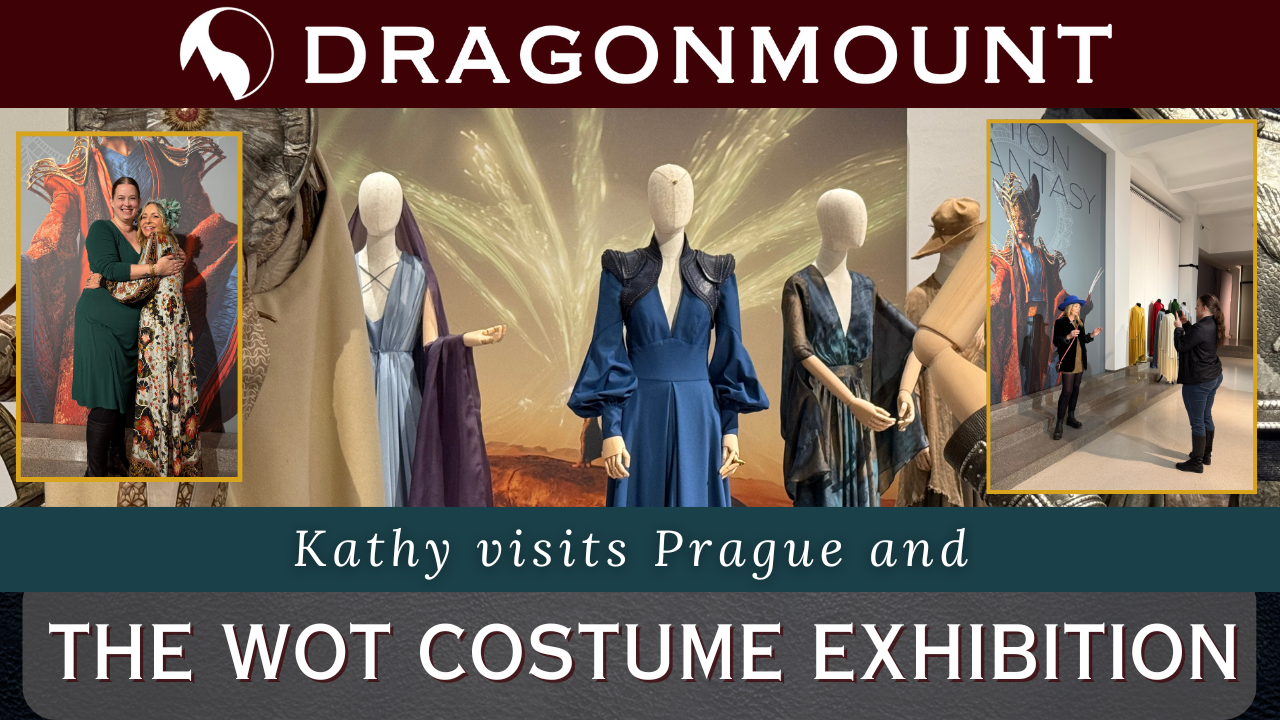News items
The Wheel of Time costume exhibition at Prague's Galerie Manes showcases over 80 breathtaking costumes, offering an unprecedented look at the intricate craftsmanship behind the show.
Read More...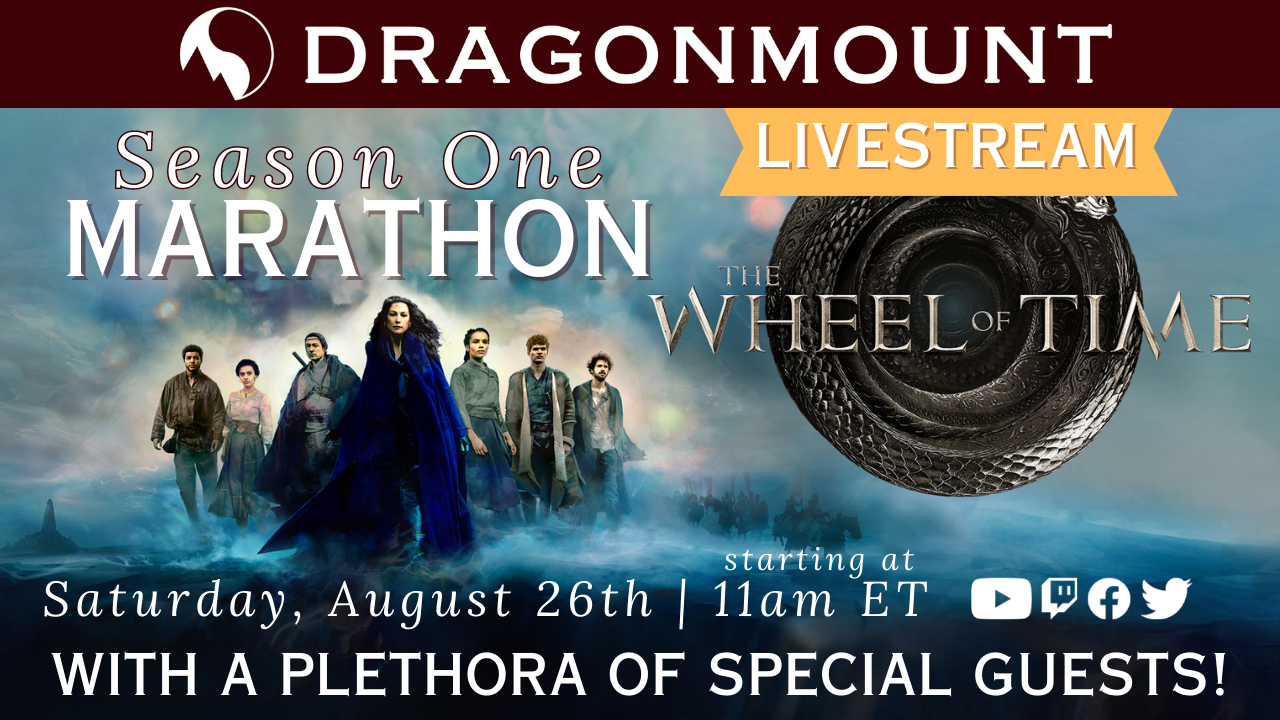
With the Second Season of The Wheel of Time on Prime Video just a week away (September first) it’s time to rewatch Season One! Dragonmount is hosting a charity livestream over on Twitch as we re-watch all eight episodes of Season One of The Wheel of Time! Beginning at 11am EDT, we will be live all day hanging out with some of your favorite content creators, with appearances from the legendary Harriet McDougal & Maria Simons. We will be raising money for the American Red Cross - Maui Wildfire Disaster Relief. If you can't make the livestream you can donate directly here. We will also be giving away some awesome prizes if you join us & donate to those effected by the Maui Wildfires. We will be giving away one set of the Eye of the World Graphic Novels for the best Closet Cosplay! Share on to social media and find out more here. Other prizes include: Show Tie-In Novel of The Great Hunt + Robert Jordan Signed book plate 2 Black Tower Podcast shots glasses and a Frosty Drinking mug Other fabulous prizes! Add your Twitch account to your active amazon prime account to join the watch party on Twitch. You can also find the livestream on YouTube. Don't forget to join us on social media! Follow Dragonmount on Twitch and Subscribe to Dragonmount on YouTube
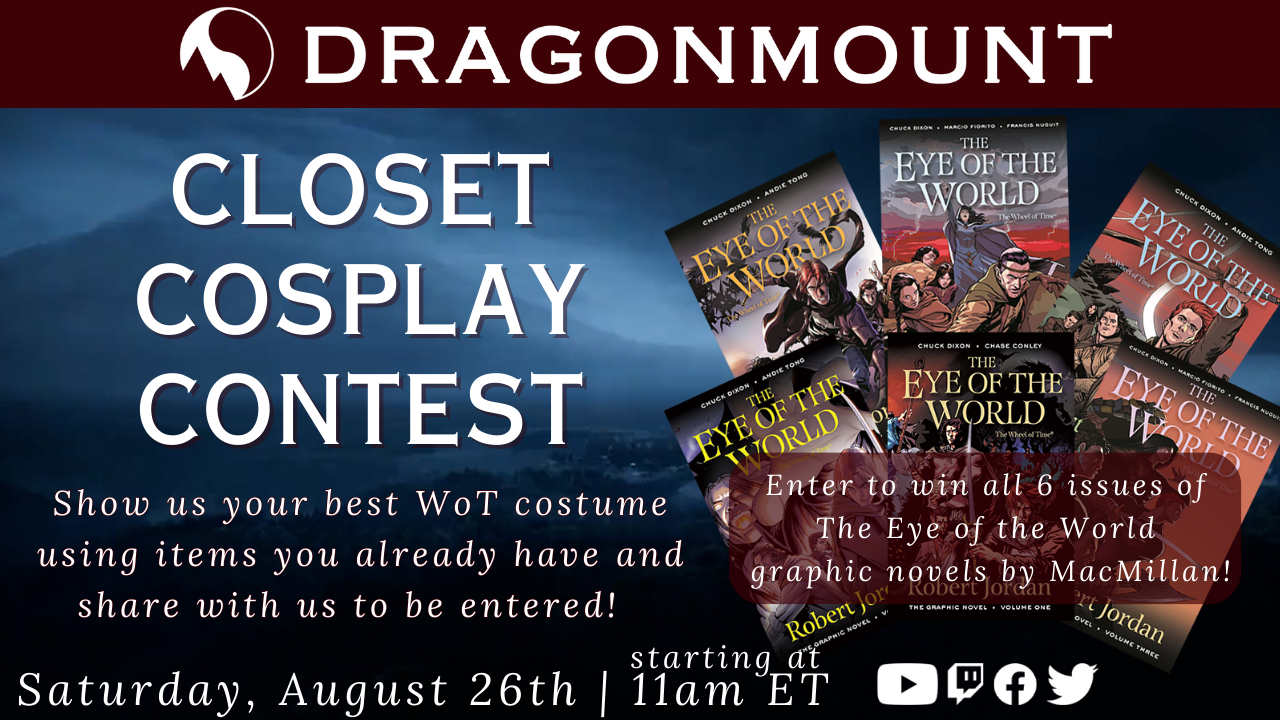
Hey there, Wheel of Time fans! It's time to dive into the fun and fabulous Closet Cosplay Contest during our charity stream marathon Aug 26th starting at 11am Eastern on our Twitch. We want you to dig deep and come up with a Wheel of Time themed cosplay. Whether you don an elaborate costume or turn everyday items into an epic ensemble, we can't wait to see your creative genius in action! When to Strut Your Stuff: The closet cosplay showdown kicks off at 11am EDT with our livestream. It's your chance to get creative and have fun while doing something awesome for charity! How to Get in on the Action: Step 1: Stick with us First things first, show us some serious love! Hit that subscribe button on YouTube and that follow button on Twitch. Why? Because this is where the magic happens—updates, fun moments, and vibes you won't want to miss. Step 2: Strut your stuff Time to bring your A-game! Strike a pose and snap a photo of your genius creation. Share your masterpiece on Twitter or Instagram. Remember to tag Dragonmount and throw in the hashtag #reWoTch to join the party. Twitter- @dragonmount & Instagram- @dragonmount_ Step 3: Lock in your shot Here's where it gets real—lock in your shot at the set of Graphic Novels by Macmillan. Donate any amount to our Charity stream. Then, pop an email with the subject line “reWoTch cosplay” over to social@dragonmount.com with your Twitch and YouTube usernames. Don't forget to attach your cosplay pic! Everyone's invited to join in for a seriously good time. But if you're aiming for the prize, you've got to go all in with all three steps. The winner must provide a shipping address within the continental United States for us to ship the prize to. How We Roll: The Dragonmount team will pick our top 5 favorite entries. These are the ones that capture the spirit, make us laugh, and have us saying, "Wow, that's pure genius!" Then YOU, your fans, your friends, and fellow Wheel of Time enthusiasts will have the chance to vote in a poll to decide who takes the Closet Cosplay crown. The Big Giveaway: We're not fooling around, folks. The winner gets their hands on something epic: the complete set of "The Eye of the World" graphic novels by MacMillan! Yep, that's a whopping 6 issues of pure Wheel of Time goodness. Mark Your Calendar: The Closet Cosplay Contest starts at 11am EDT at the start of our live stream. Make sure you've done all 3 steps by 8pm EDT during the marathon. The winner will be announced on Monday! Get ready to show us your Wheel of Time style, and may the most epic closet cosplayer win! 🌟
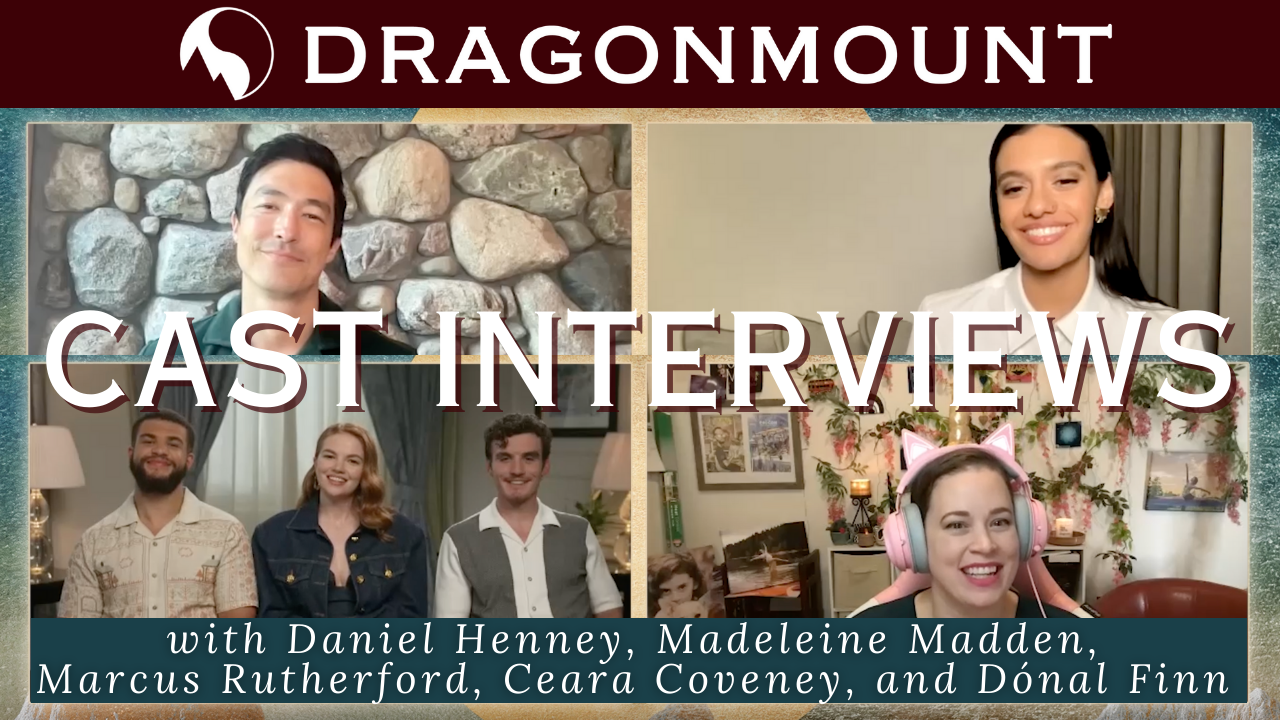
With two weeks to go until the premiere of the second season, we can share Dragonmount’s interview with the cast of the Wheel of Time Season two! Kathy Campbell was lucky enough to get five minutes to chat with Madeleine Madden and Daniel Henney, and then Marcus Rutherford, Dónal Finn, and Ceara Coveney. The cast reveals what they are most excited (and nervous) for book fans to see in Season Two! The interviews occurred in June 2023, before the SAG-AFTRA strike began. Check out the video over on YouTube: The second season of The Wheel of Time will be released on September 1st. We cannot wait to see our favorite characters on screen again!
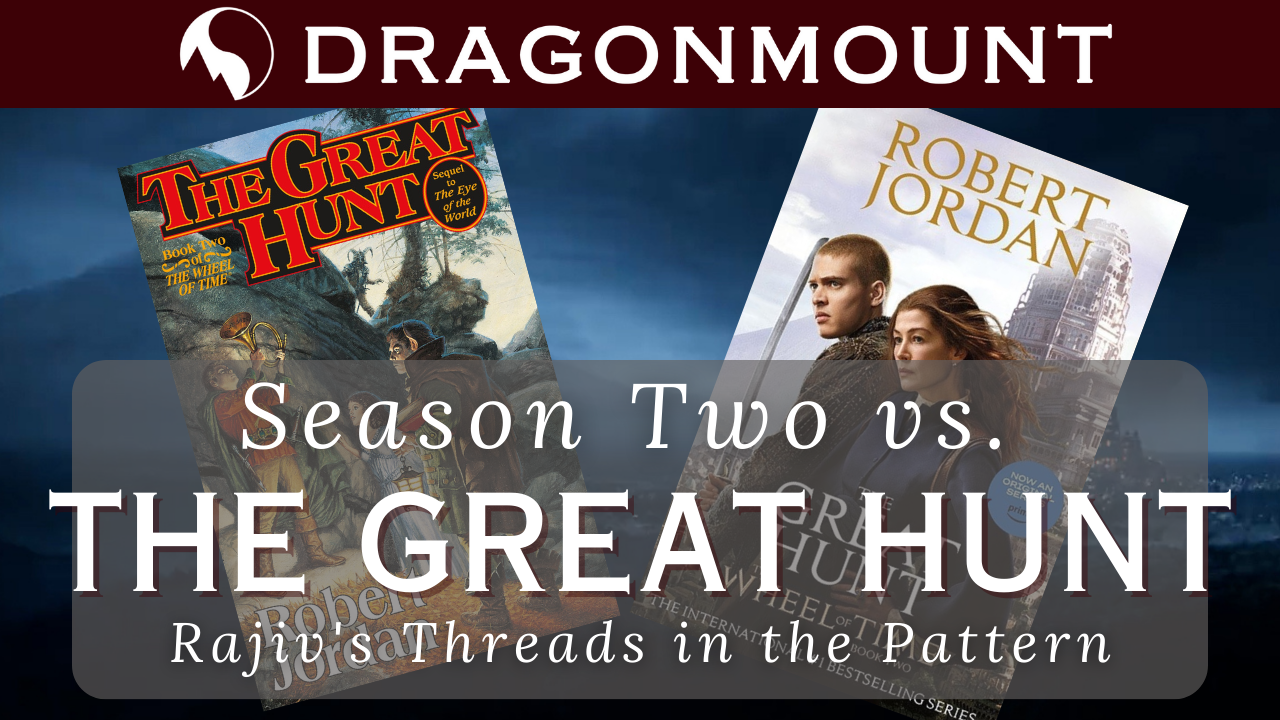
Rajiv Moté is Dragonmount’s book blogger with a lens on the craft of fiction writing. When he’s not directing software engineers, he writes fiction of his own, which can be found cataloged at his website. The trailer for Prime Video’s The Wheel of Time season 2 has arrived at last, and fans of the books are wondering whether their favorite scenes will appear, or if this turning of the Wheel will spin things differently. Dragonmount has a helpful set of summaries if it has been a while since your last re-read. The end of Season 1 left things in a different place than the end of book 1. Rand al’Thor, the Dragon Reborn, has set off alone to protect others from the madness that he knows will consume him. He seems more the Rand of the beginning of book 3. Moiraine has been exiled from the Tower by Siuan, shielded from the One Power by “the Dark One,” and her bond with Lan is inaccessible. (It raises the question if this shield has affected other things, like the oaths taken on the Oath Rod, or if it was just “stuck on fuzzed.”) Nynaeve and Egwene are still in Fal Dara with Moiraine and Lan. Perrin is dealing with his pacifism having allowed Padan Fain to escape with the Horn of Valere, seemingly at the cost of Loial’s life. In the biggest departure from the books, Mat stayed behind in Tar Valon, never making the trip through the Ways to Fal Dara. The prologue of The Great Hunt kicks us off with the “Darkfriend Social,” a gathering of hooded and cloaked Darkfriends from across the land, assembled to take orders from “the Dark One.” The trailer for Season 2 does show us a group of hooded and cloaked individuals gathered around a table (we see even more of this gathering in a bonus scene following the season 1 finale!), and even Liandrin sneaking around Tar Valon with her hood up--although she has plenty of others to meet, and standing business in North Harbor. Speaking of Liandrin, she’s also shown with the Great Serpent Ring forge. In the show, Great Serpent Rings are Ajah-specific, so Novices and Accepted couldn’t pass for Aes Sedai if they were to venture out into the world on secret business. Just saying. The Great Hunt continues showing that some time has passed following the meetings at the Eye. Lan is training Rand to use his heron-mark sword, an investment that will pay off when Rand faces the Seanchan High Lord Turak. Lan also teaches Rand a warrior’s comportment; how to stand with pride even when facing as imposing a figure as the Amyrlin Seat. In the trailer, Rand does face Siuan Sanche, but given that he has wandered into the Blight/Waste at the beginning of the season, this meeting seems likely for later in the season. Without Rand or the Horn, there isn’t much reason for Siuan to make the trip to Fal Dara. Padan Fain has already made off with the Horn of Valere, so the inciting incident for the Hunt for the Horn has already happened, and without Rand’s presence, or Mat needing his dagger, the duty falls to Perrin. His stake is the most personal--he let Fain get away--and unless Hurin has been cast, Perrin’s ability to talk to wolves is their only way to track the Horn. Will we see a Fade nailed to a door by Padan Fain? I sure hope so. In The Great Hunt, Siuan and Moiraine plot to use the Hunt as a way to groom Rand to lead the Shienarans, including supplying him with fancy coats and the Dragon Banner. The trailer also shows Rand swaggering in fancy coats, but this new sequence suggests that someone else is responsible for Rand’s new confidence. Lanfear, rising from what looks like a pool of blood, has been freed, and her first priority is to cozy up to Lews Therin reborn and groom him to stand beside her at the apex of power. Rand appears to be learning how to channel as well, and is even conversing with Logain. How much of this is through Lanfear’s orchestration (in the books, she caught Rand his first male teacher, at the end of book 4) remains to be seen. The Dark is still in pursuit of Rand, and it looks like Rand is learning enough to put a sword of flame through a Fade. By the time Rand reunites with Moiraine, he’s angry, full of his own power, and willing to choke an Aes Sedai. Siuan says he can’t be controlled, though it’s unclear if she’s telling Moiraine and if, despite the Oath, the lovers are reunited outside of a flashback. There are scenes of Rand bound to a wheel, a rather on-the-nose representation of his fate. These images are likely Lanfear messing with Rand’s dreams, trying to get him to rebel against his destiny. Indeed, when Rand faces the Amyrlin Seat, he tells Siuan that he doesn’t want to be a spoke on the Wheel, and Siuan responds that Rand is the water that turns it. The trailer confirms that Nynaeve and Egwene reach the White Tower, and are joined by Elayne. Verin is cast, so perhaps she takes them, since Moiraine can’t return to the Tower if her Oath holds. Nynaeve takes her test for Accepted and emerges with wounds. There is a scene in the trailer where Nynaeve is wielding a sword, with two other swordsmen visible. This could reference the book conversation with Siuan, where Nynaeve says that she doesn’t need the Power when a sword would do. It could even be a scenario in her testing. Or maybe she’s just wielding a sword. She killed a Trolloc with one, after all. There is probably no need for Portal Stone flickering realities, as Rand and Lanfear have already been separated from the Hunt for the Horn, but the trailer does show us a laughing Perrin with a young girl who could be his daughter or a little sister, which may be one of his alternate realities. Or, it could be a Wolf Dream. The trailer shows Perrin coming to terms with talking to wolves, and his eyes turn golden. There’s no indication from this trailer whether Moiraine visits Adeleas and Vandene (with the Dragkhar attack), Rand encounters the Choeden Kal, or Min reconnects with Nynaeve and Egwene at the White Tower. We know Thom does not appear this season. We know Elayne is at the Tower, and a glimpse of the business end of Mat’s quarterstaff suggests that book 3’s sparring with Gawyn and Galad may occur. The Shadar Logoth dagger is still somehow associated with Mat despite his separation from it last season. There’s a fiery explosion, but whether it’s an accident at the Illuminator chapterhouse or Seanchan damane doing battle is yet to be seen. The trailer doesn’t indicate how much of Cairhien and Barthanes’s cocktail party will be in the adaptation. In the book, it’s Barthanes who tells Rand that Fain is waiting on Toman Head. Ultimately, the book has everyone converge on Toman Head, and this is reflected in the trailer. Perrin’s party, after fighting Whitecloaks (and being aided by Aviendha and the Aiel), becomes prisoners of the Seanchan High Lord Turak, and the Horn of Valere falls into the invader’s hands. Nynaeve, Egwene, and Elayne come to the rescue (sent along by Liandrin, in the book), and Egwene becomes a prisoner of High Lady Suroth’s sul’dam. She goes down fighting with the Power, in the trailer. We do see High Lord Turak, a blademaster, unsheathe his sword, but it’s uncertain whether the show’s Rand has had sufficient training with Lan to beat him like in the book. Could Lan fill the role of Turak’s slayer? I kind of hope not. This trailer does not show the Horn of Valere being blown, nor the Heroes of the Horn doing battle with the Seanchan. Season 1’s finale was sufficiently different from The Eye of the World that the show may have its own conclusion planned. Does Mat get bound to the Horn? Or does Perrin? Or does the Horn get blown at all? The press interviews promise us a huge battle this season. Watch and Find Out, I suppose. If I’m interpreting the trailer correctly, this season is hewing much closer to the outline of the second book than season 1. The major differences are with Mat and Thom. But as a fan of the books, I felt like I was back in familiar territory, among friends. I’m excited for the first three episodes streaming on September 1st.
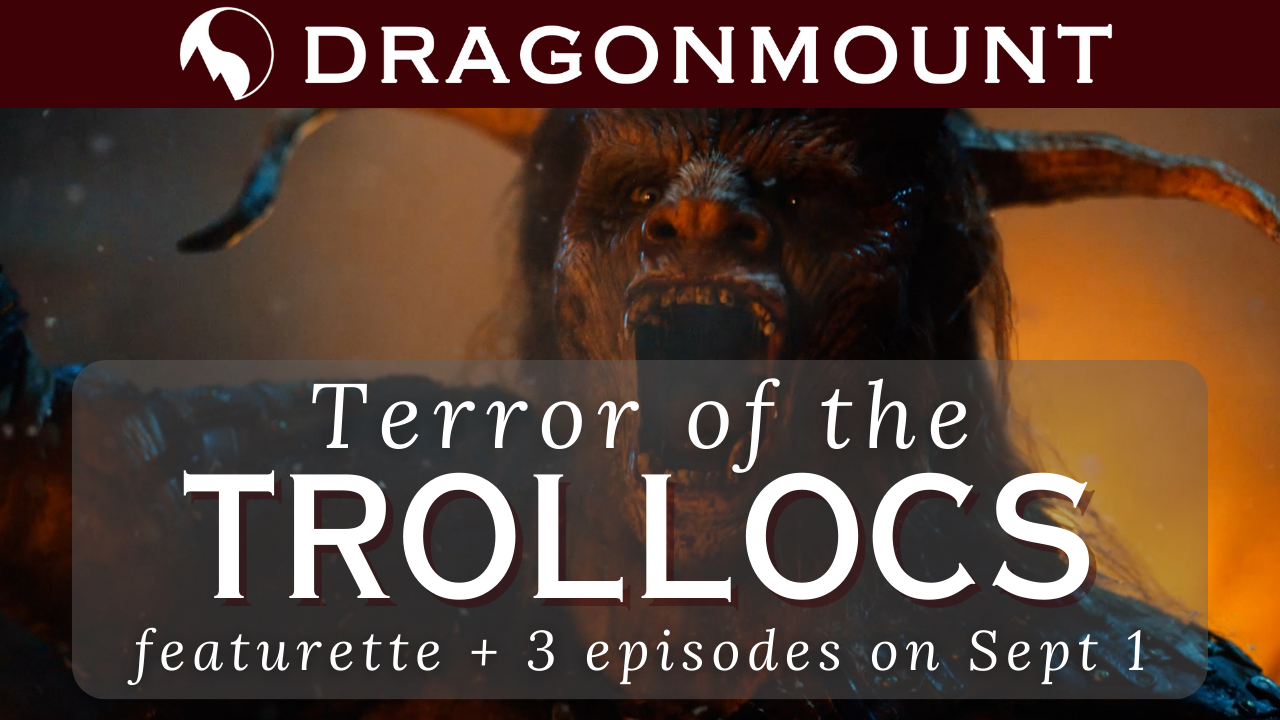
With the second season of The Wheel of Time just a few weeks away we are getting weekly WOT Wednesday news. Today was a new trailer with the big news that the first three episodes of the second season will drop on September first. The other big drop today was a behind-the-scenes look at the Trollocs the “nightmare fuel” monsters for the dark. We hear from Rosamund Pike showrunner Rafe Judkins producers Mark Weber and Justine Juel Gillmer and make-up designer Nick Dudman. The trollocs are genetically engineered creatures created through a mix of human and animals like birds boars and bears. The show used a mix of practical and visual effects for the trollocs. We see both the creation of the practical with stilts and horns. And the cgi visual effects: The featurette shows how some of the stunts were performed and more behind the scenes of the creation of the Trollocs. “They are more than just monsters there is a human piece” The humanity of the Trollocs is what makes them horrifying, not knowing how much they understand and think for themselves. It seems the second season will explore the complexity of the dark and hopefully will explore the humanity of the Trollocs. We can’t wait! What are you looking forward to seeing in the first three episodes? Let us know in the comments below!
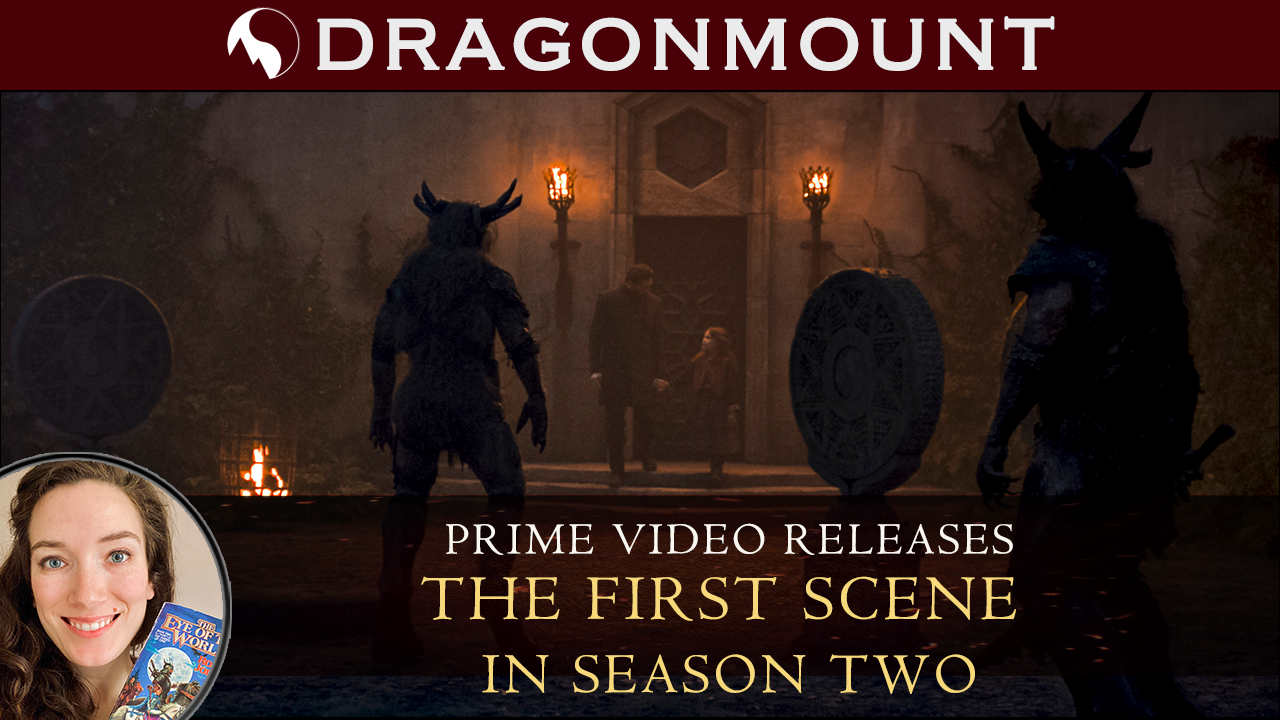
Our newest WOT Wednesday drop is here and it’s a sneak peek of the first scene in Season Two of The Wheel of Time!! Today started off with a quick video that hinted at our new drop - that the first scene of Season Two will play directly after the finale of Season One. It’s a scene many of us fans have been hoping to see, and we get to see it a month early! Head over to the Prime Video app, and at the end of Seasons One, episode 8, the new sneak peek will play. The scene will be familiar to fans of the books of a scene in The Great Hunt that starts off from the perspective from a new character, a dark friend who calls himself “Bors” who attends what fans endearingly call “the dark friend social.” The sneak peek scene starts off with a young child playing outside, who sees monstrous trollocs appear out of the mist. She runs into to a gathering of figures robed in black. The Man/the Dark One/ Ishamael (played by Fares Fares) pops his head down to let her know she’s interrupting their meeting. A meeting of who appear to be dark friends!! We see: a Seanchan with long fingernails, an Aes Sedai with their stone colored black, a warrior with a hawk sigil, and the child’s mother. We also see Padan Fain pull down his hood and grin at the child. The main theory is that the girl and her mother are tinkers, but there’s a suggestion that they might be from Falme. Ishamael discusses a man, not yet the dragon reborn, called Rand Al’thor. The scene ends with an intriguing and very creepy chat between Ishamael and the child about hungry trollocs and who we consider to be monsters. It’s not an exact recreation of the book scene, but it is a gathering of dark friends where the name Rand Al’thor is revealed. There are more figures around the table, maybe fans will dissect the scene until we figure out who’s there, or maybe we will have to wait until we see the whole of Season Two! If you want to see thoughts from Thom at Dragonmount, go check out the livestream he did all about the sneak peek! Today we also got a (previously recorded) video featuring Rosamund Pike, Josha Stradowski, Marcus Rutherford, Dónal Finn, and Ceara Coveney explaining five things to remember about Season One of the Wheel of Time. Season Two of the Wheel of Time will release on September 1st 2023 on Prime Video. What do you guys think of our preview? It’s so creepy and gives us lots to theorize about!
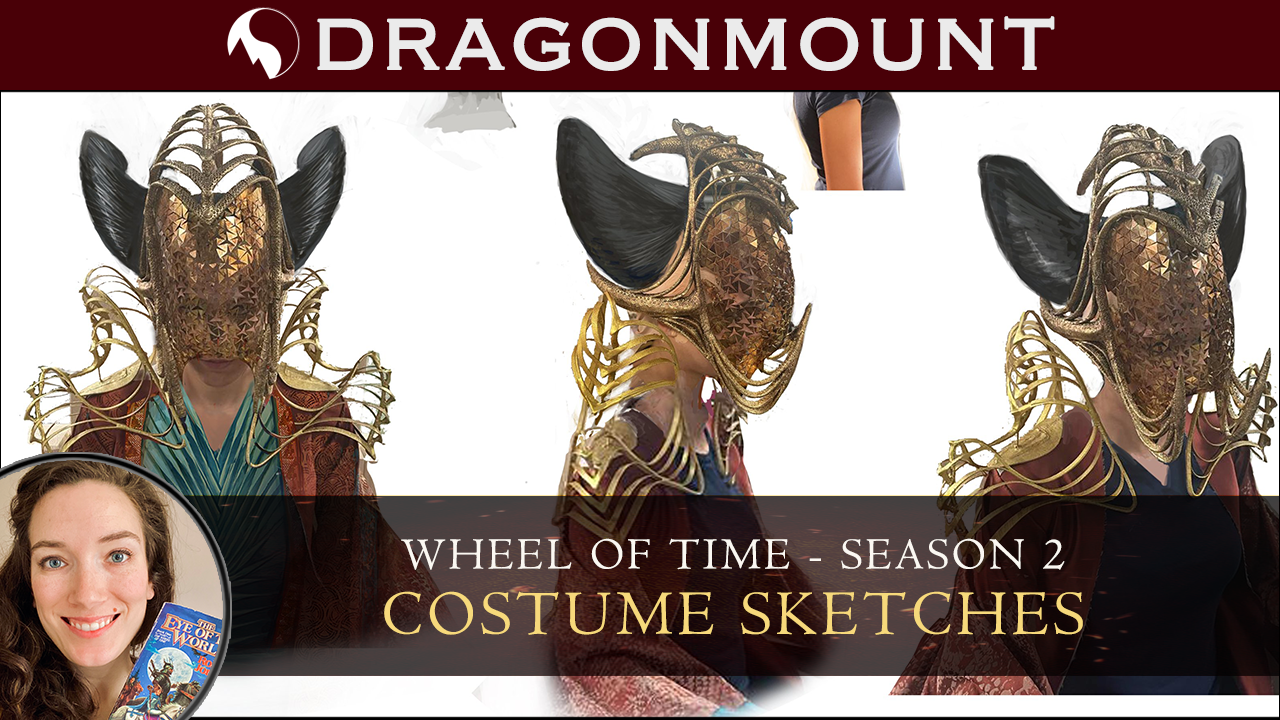
With the second season of The Wheel of Time just around the corner, we are starting to see weekly WOT Wednesday posts. This last week, on Wednesday July 26th, was all about Season Two costume design from Sharon Gilham. As part of the drop The Nerdist interviewed Sharon Gilham. She had some interesting things to say so lets see what costumes might mean for the storyline of Season Two! Sharon is the new costumer designer for season two, having previously designed for The Stranger and Jamestown. She’s also quite active over on instagram, so make sure you follow her over there! Let's take a closer look at the new sketches! First up is the Amyrlin Seat herself: Siuan Sanche played by Sophie Okonedo. Similarly to how we see her in Season One, Siuan is wearing ornate gold gowns in her official role as leader of the White Tower. It's very interesting how the costume design has chosen to not include a very visible striped stole like described in the book. Both seasons have had a more subdued inclusion of all the Ajahs on the Amyrlin's clothes. I hope we see a few good shots in the show of the back of her cape! In the photo they released, we only see the front of her outfit. Siuan dresses like the most powerful person in the world with the richness of her gown and robes and headdress. For all of Robert Jordan's elaborate descriptions I don't remember ever reading about a headdress for the Amyrlin. It definitely makes her stand out in a crowd! Next up we have Moiraine Sedai, played by Rosamund Pike. The final look went for more solid coloring for Moiraine. I'm a little bummed that we don't see her in something with pattern, even though the solid colors seem to suit Moiraine better. I think the pattern would have shown how she's outside her element being back in Cairhien. It appears that's where a good part of the story for Season Two takes place in Cairhien. Moiraine wasn't in Cairhien with the rest of the characters in book two, The Great Hunt, but with her history (and the fact that she's a Damodred, part of the royal house of Cairhien) it feels realistic for her to be there. The photo of Moiraine of the final costume is (annoyingly) cut off, so we can't see if she is wearing a shorter skirt here like in the sketch. The Japanese influences are quite clear in the top of the dress, sleeves and belt. Next we move over to a whole other continent, a whole other culture - the Seanchan! This civilization from across the sea has a different history and culture than the ones we've been introduced to so far. Robert Jordans descriptions are so vivid of insect like helmets etc. First up we have High Lady Suroth. The actor for this role has not been officially announced yet, so some speculation continues! Okay there's so much that's so cool about this costume! First let's look at what costume designer Sharon said about Lady Suroth: The Seanchan are obsessed with status, and their clothes must reflect that. Lady Suroth's elaborate headpiece hides her head (which sounds like there's more under the mask than we might expect). Yet there's so much that is from Robert Jordan's descriptions - the long nails, the pleated robes. I can't wait to be absolutely terrified by this group. There's always different reasons for changes from the book descriptions, what it okay in written word doesn't always translate to television. Sometimes there's practical considerations. And sometimes you have to go all out like 12 in long fingernails. Yes, they are not lacquered. But they are soooo long as we can see in the photo of the final costume. The last group has the lowest social status of the Seanchan empire - those who can channel, or Damane. We don't have any official announcements for the actors playing damane in Season two. In the books the damane are collared and leashed to the Sul'dam, those who control their channeling. In the show, it appears the collar is more of a chest brace than dog collar. The Sul'dam have a bracer or arm cuff rather than a bracelet. Part of Seanchan hierarchy is about who is allowed to speak. This is a very visible way of communicating that the Damane don't have a voice or any control over their own lives. The mouthpiece is also similar in shape to a device used during the eras of Slavery in the United States to prevent the enslaved from eating. One other interesting thing to note is that Sharon says the collars can be removed when a damane dies. That has interesting implications for the story line of season two. We will have to see how the characters handle that bit of information. Seeing these costumes (and some of the shots from the trailer) make me very nervous for one my favorite characters. It's hard to read about the treatment of the damane, seeing their lives on TV will be absolutely heartbreaking. That a wrap on WOT Wednesday costumes! Can't wait for what we will see next week. What do you guys think of the costume sketches? Let us know in the comments below!
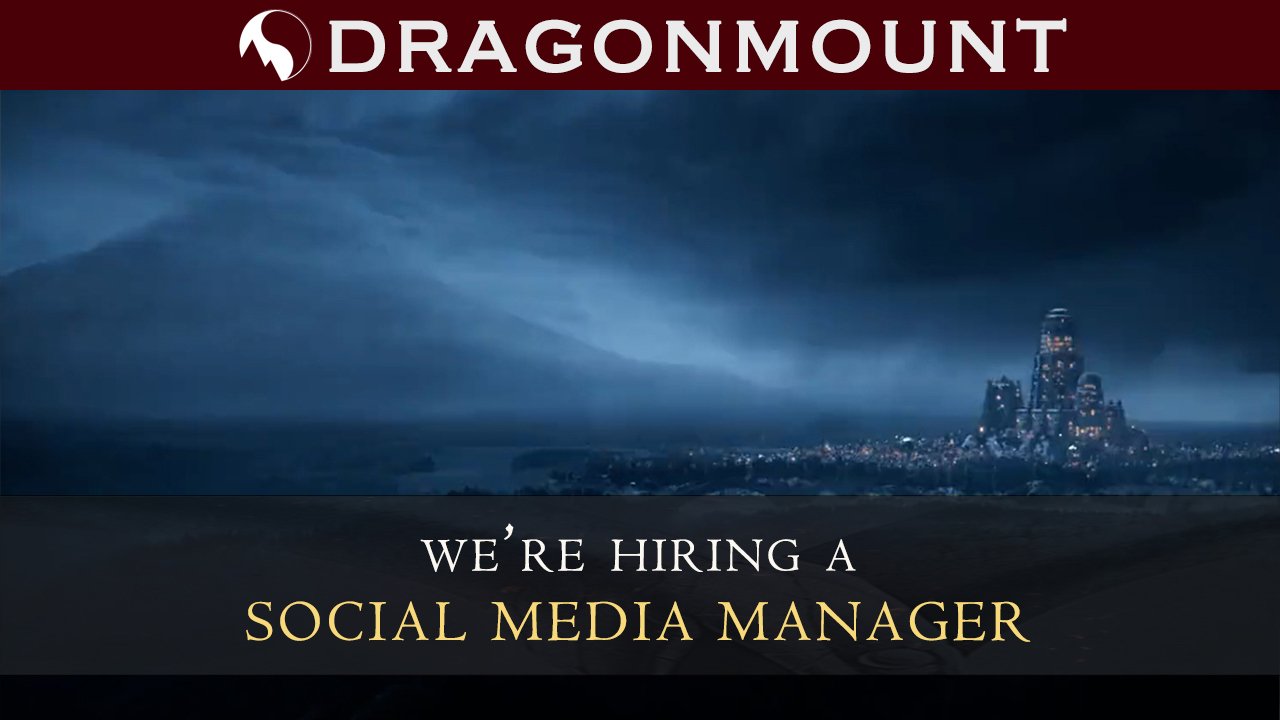
Over the past 25 years, Dragonmount has grown and changed so much. The purpose and goals of the community have adjusted to move with the times, and now, with the changing of the guard, it’s time to ramp up even more. In order to make sure the community receives the best access, we are looking for someone to manage our social media and other external communications. This role will receive monetary compensation! We strongly welcome applications from members of minority groups, and we do not discriminate on the basis of sex, sexual orientation, religion, disabilities, etc. What will this entail? Social Media - providing news/updates/engagement across all of our social media platforms: Twitter, Instagram, Threads, Facebook, Discord, etc Patreon - sending updates for Patreons with information collected from our different branches, other goodies, and plans just for our Patreon members. Newsletter - sending at least monthly newsletters to our list with updates across the company, including featuring merch, social media campaigns, videos, etc Extras - You’ll be a part of the team, and that means you’ll get to be involved in some of the great things we’re lucky enough to participate in (in-person screenings, red carpet, interviews, etc.) This means we’ll want to use your help to make Dragonmount amazing! Time Expected - Will be different depending on the news cycle and your engagement plans, but less than 5 hours a week if efficient. Who are we looking for? You are passionate about The Wheel of Time and the community as a whole. You want to contribute to one of the oldest Wheel of Time communities. Knowledge of social media platforms, ideas on how to leverage it to grow the community and engagement, and a desire to make Dragonmount become even more amazing! You have the time in your day to be able to quickly prep and share new information when Prime Video sends out announcements (sometimes last minute…sometimes we get advanced notice). We are looking for someone behind the scenes to spearhead our ever-growing social media presence. You will not be required to be in front of the camera. Is this you? To apply, please fill out this Google Form If you have any questions, feel free to send an email to kathy@dragonmount.com.
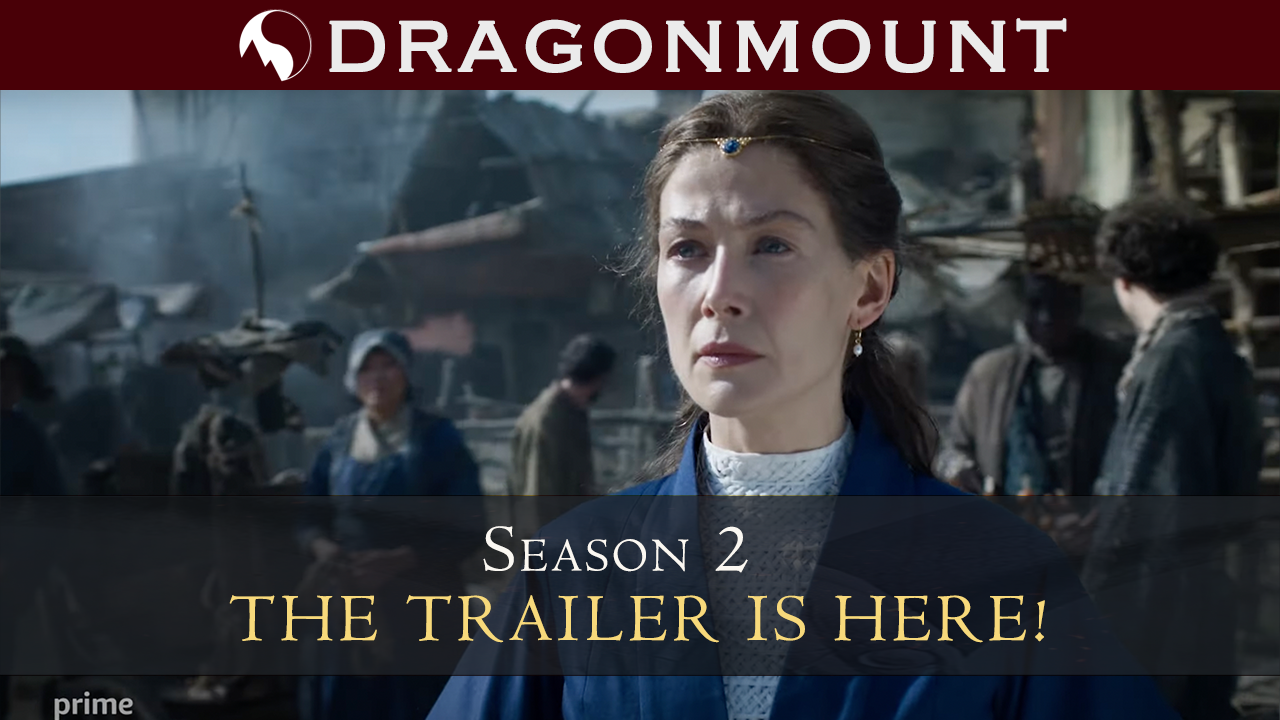
This morning we have the first official trailer for Season Two of The Wheel of Time. The Wheel of Time will premier on September 1st 2023. The second season covers content from books two: The Great Hunt and parts of book three: The Dragon Reborn. There's also news about WOTwednesdays, which is returning! If you have the availability to support industry folks impacted by the WGA & SAG-AFTRA strike, please consider contributing to the entertainment community fund.
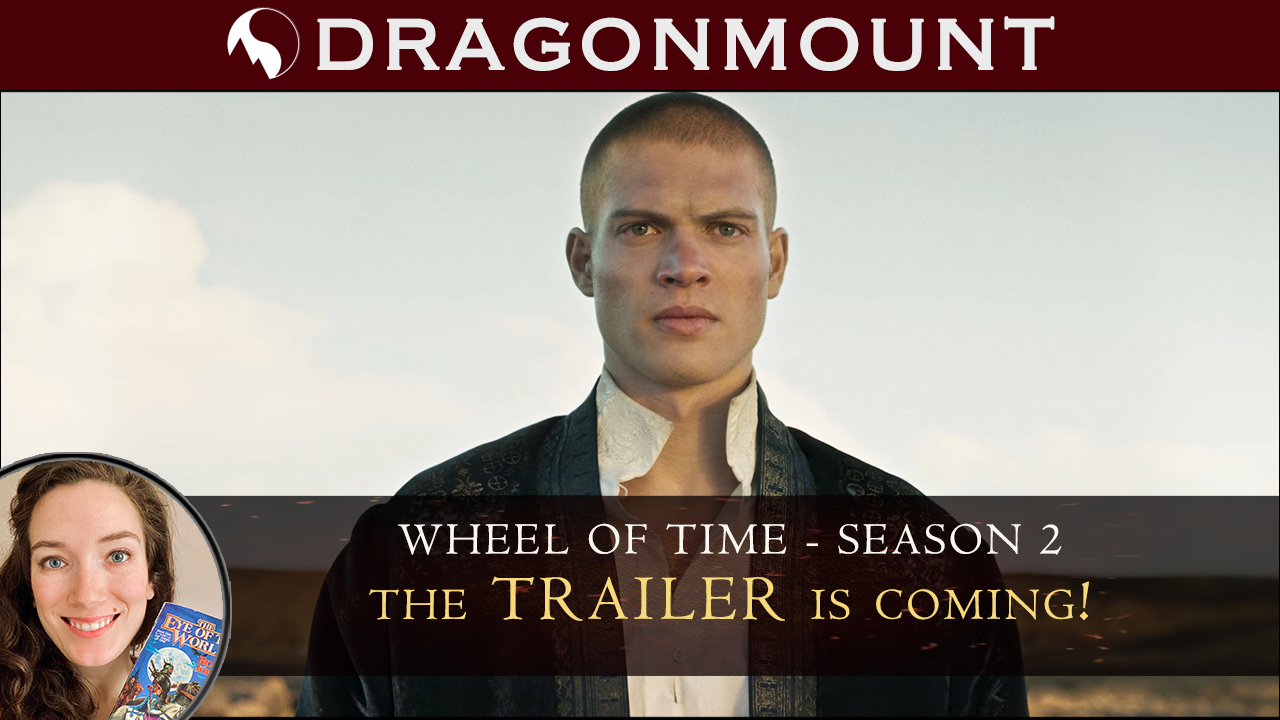
The Wheel of Time social media accounts have announced that we will see the trailer tomorrow morning, July 18th at 6am pacific. Today we've also seen a few more photos from season two including Rand, Nynaeve and the Seanchan. Last week we saw the official poster for season 2 featuring all our favorite main characters: It's been nearly two years since we saw the the trailer for Season One of the Wheel of Time. It was such a fun time reacting to the trailer and sharing the experience together over on YouTube. If you have the availability to support industry folks impacted by the WGA & SAG-AFTRA strike, please consider contributing to the entertainment community fund.

Starting today, Dragonmount will be resuming our coverage of Season Two of The Wheel of Time. We fully support WGA & SAG-AFTRA strike. After consulting with people connected to the show and the union directly, we’ll cover the show itself, but no specific companies or any other struck work Even though The Wheel of Time show is not a SAG project, the actors and writers cannot promote it themselves at this time. We fully support them on this incredible project and want to see it succeed. If you have the availability to support industry folks impacted by the strike, please consider contributing to the entertainment community fund. Stay tuned to Dragonmount for some exciting news!

The Wheel of Time is returning on September 1st, 2023 to Prime Video! Entertainment Weekly also published first look photos of season two. The photos include a good look at the Seanchan with the Fares Fares as the Dark One and Hammed Animashaun as Loial, Dónal Finn as Mat Cauthon, and the rest of the main cast, including Rosamund Pike as Moiraine, Madeleine Madden as Egwene, Daniel Henney as Lan, Zoë Robbins as Nynaeve, Josha Stradowski as Rand, Marcus Rutherford as Perrin, and Aoolya Smart as Aviendha. We've previously seen some behind the scenes content about Season Two including a sizzle reel during San Diego Comic Con, a sneak peek during New York Comic Con and an interview and casting announcement during JordanCon. The Wheel of Time Twitter account also posted this clip from Josha Stradowski responding to twitter user "Default Rand" who has been asking the official account everyday for the release date. Day 449 is the one! Less than 100 days until release! Who's planning a watch party? Let us know in the comments below.



